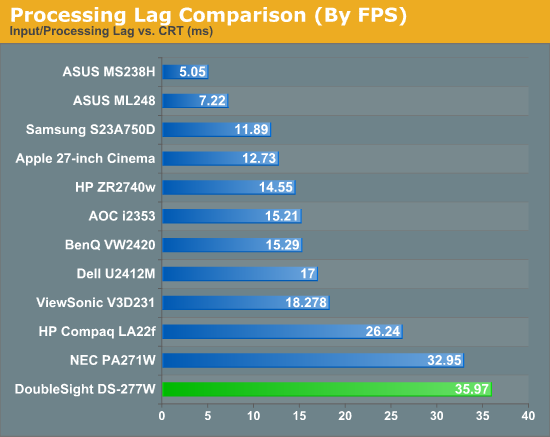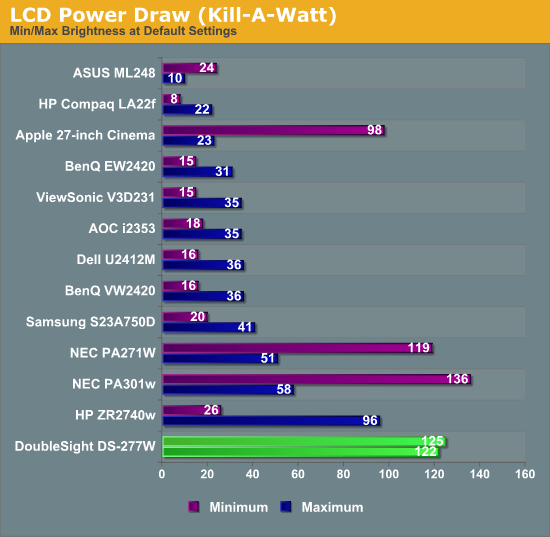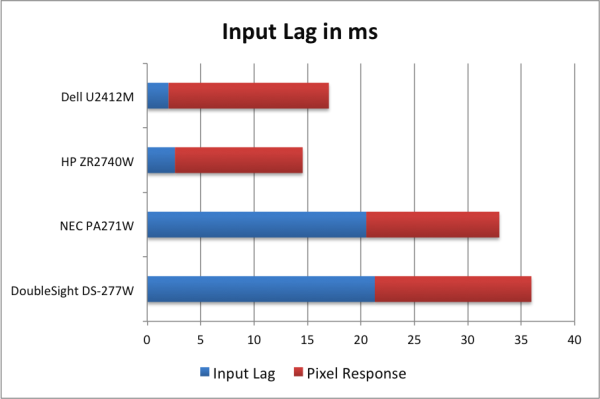DoubleSight DS-277W: Back to the Drawing Board
by Chris Heinonen on June 13, 2012 1:30 AM ESTSince all LCD displays have to be compared to a CRT display to calculate the lag, all of the testing is done at 1920x1080 resolution to keep the aspect ratio constant on the DS-277W. This might introduce a bit of an input delay, but because we use SMTT now to test displays we can separate input lag from pixel response to be more accurate.
Using SMTT, the DS-277W exhibited right around 21.3ms of input lag, and it took a full 29.3ms for a pixel to switch colors and come back, and combined this gives us an average response time of 36ms. This is over two frames of delay, so for many people this will not be an acceptable number for heavy gaming. Since the HP ZR2740w offers far faster pixel response time, and costs less to boot, that would be the 27” display I would still recommend with gaming in mind.

The DS-277W ships with an external power brick, and it seems to draw full current, all the time. At minimum brightness it was using 122 watts and at maximum it was drawing 125. Running at lower brightness to save on your energy bill isn’t a concern here, as the DS-277W is going to use a lot of power no matter how you have it setup.

I also tried to test out the DS-277W as a video display, since it has many inputs to use for this. Using an Oppo BDP-93 Blu-ray player, my first discovery was that in 1:1 mapping mode, it crops pixels from an HDMI signal. Losing 11 pixels on each side and 5 on the top and bottom, this is around 1% of overscan in effect, and there is really no reason for this at all. I did test using a PLUGE pattern from the Blu-ray player and found that the brightness control behaved the same over the HDMI input, controlling the black level as you’d expect on a TV.
Testing component didn’t even get that far. Once again using the Oppo player, which has a near perfect component video output, I couldn’t get an image on the screen at all. Using the Oppo BDP-83SE player instead also resulted in no image, so either the component video on my test LCD didn’t work correctly, or it didn’t like the timing of the Oppo players, or something else is just incorrect with the component video. Needless to say I wasn’t happy with the video testing results.











55 Comments
View All Comments
esSJae - Thursday, June 14, 2012 - link
FireWire was the only solution for external hard drives until USB 2 came out. I had FW on my Dell work laptop back in 2002.FireWire was also great because you could chain devices together.
Zoomer - Wednesday, June 13, 2012 - link
nVidia, AMD and Intel have all committed to DP. They will start the phase out of DVI, probably by going to just 1 TMDS per card. Why get something that's going to be a 2nd class interface standard really soon?Most cards, even lower end ones, have come with DP for years now.
Guspaz - Wednesday, June 13, 2012 - link
My current videocard has DP. My current monitor (a Dell U2711) has DP. My monitor came with a DP cable. As a result, I'm using DP to connect my monitor.There is, however, one major downside: if both HDMI and DP plugs are connected to an nVidia card, it boots on the HDMI port. This means that on my computer, I only see the BIOS and boot screens on my home theatre projector, not my LCD monitor... this is really dumb.
Zoomer - Saturday, June 16, 2012 - link
It's a software issue that will be fixed. Maybe ask nvidia/your card manufacturer?Dug - Wednesday, June 13, 2012 - link
Thunderbolt uses the same connection as display port (mini) so I don't see it going away.SodaAnt - Wednesday, June 13, 2012 - link
Well, I am that one person. I have a Dell Precision m4600 that I connect to my Dell u3011 with a displayport cable, no adapters involted.LordOfTheBoired - Wednesday, June 13, 2012 - link
I use DP. And I adopted it before Apple did.It's a good standard, and it deserves more support than it's getting right now.
Also, Apple's new "best interface ever" is Thunderbolt. Which... uses DP for video, and the now-standard mini-DP connector.
InsaneScientist - Wednesday, June 13, 2012 - link
Every single person I know who has a WQXGA (2560x1600) or WQHD (1560x1440) monitor (myself included) has it connected using Display Port.HDMI never seems to work despite the fact that HDMI 1.4 supposedly will, and dual-link DVI (as already mentioned) is a pain since you have to make sure that the port that you're connecting to is dual link and the cable is dual link...
An $8 Display Port cable just works... assuming that the monitor supports it.
Oh, and none of the people I know with monitors at that resolution are mac users, ironically enough.
JarredWalton - Thursday, June 14, 2012 - link
Apparently everyone with a 30" WQXGA or 27" WQHD display that you know also purchased their displays relatively recently (last couple of years). I've got a 30" display and it's using DL-DVI; same goes for most others with 30" displays that I've met (all five or so of them!) But for newer displays yes, DP is becoming far more mainstream.Voo - Saturday, June 16, 2012 - link
Actually I do use DL-DVI on my relatively new Dell U3011 - why?Because Dell included the DVI cable but no DP cable in the package and I really don't see any advantages in DP over DL-DVI.